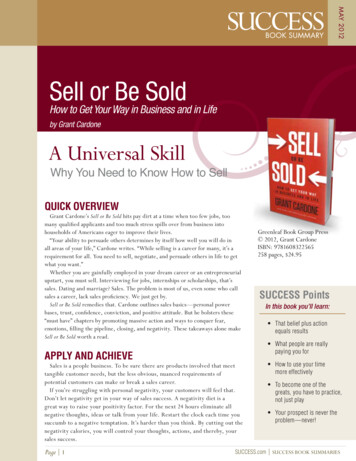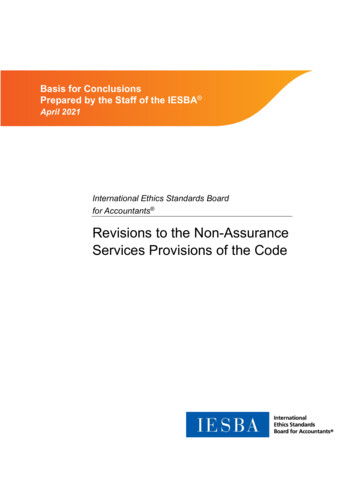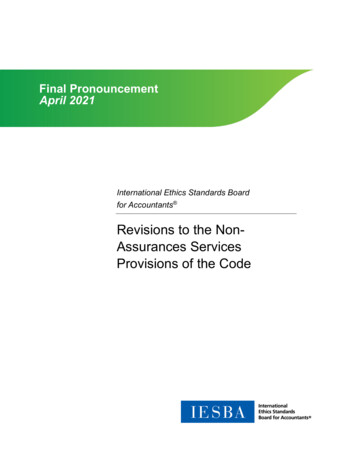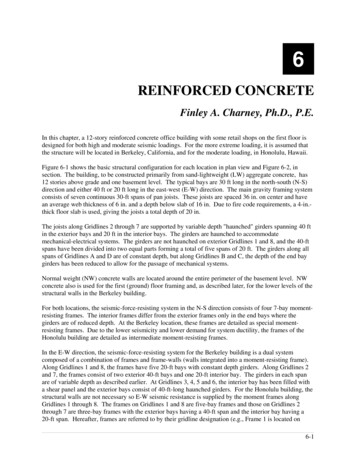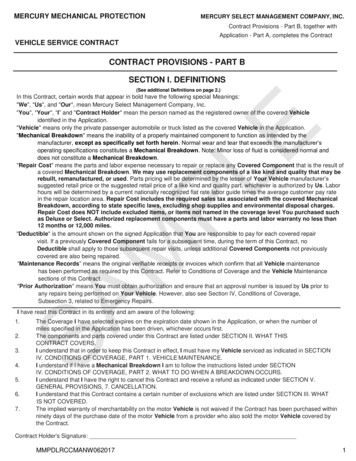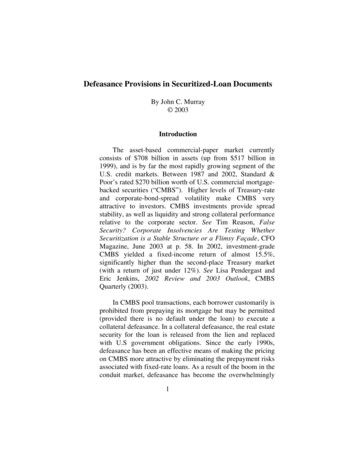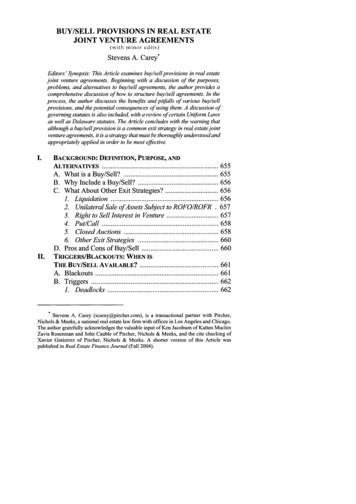
Transcription
BUY/SELL PROVISIONS IN REAL ESTATEJOINT VENTURE AGREEMENTS(with minor edits)Stevens A. Carey·Editors'Synopsis: This Article examines buy/sell provisions in real estatejoint venture agreements. Beginning with a discussion of the purposes,problems, and alternatives to buy/sell agreements, the author provides acomprehensive discussion of how to structure buy/sell agreements. In theprocess, the author discusses the benefits and pitfalls of various buy/sellprovisions, and the potential consequences of using them. A discussion ofgoverning statutes is also included, with a review ofcertain Uniform Lawsas well as Delaware statutes. The Article concludes with the warning thatalthough a buy/sell provision is a common exit strategy in real estate jointventure agreements, it is a strategy that must be thoroughly understood andappropriately applied in order to be most effective.I.BACKGROUND: DEFINITION, PURPOSE, ANDALTERNATIVES . 655A. What is a Buy/Sell? . 655B. Why Include a Buy/Sell? . 656C. What About Other Exit Strategies? . 6561. Liquidation . 6562. Unilateral Sale ofAssets Subject to ROFO/ROFR . 6573. Right to Sell Interest in Venture . 6574. Put/Call . 6585. Closed Auctions . 6586. Other Exit Strategies . 660D. Pros and Cons of Buy/Sell . 660II.TRIGGERS/BLACKOUTS: WHEN ISTHE Buy/SELL AVAILABLE? . 661A. Blackouts . 661B. Triggers . 6621. Deadlocks . 662 Stevens A. Carey (scarey@pircher.com), is a transactional partner with Pircher,Nichols & Meeks, a national real estate law firm with offices in Los Angeles and Chicago.The author gratefully acknowledges the valuable input of Ken Jacobson of Katten MuchinZavis Rosenman and John Cauble of Pircher, Nichols & Meeks, and the cite checking ofXavier Gutierrez of Pircher, Nichols & Meeks. A shorter version of this Article waspublished in Real Estate Finance Journal (Fall 2004).
65239 REAL PROPERTY, PROBATE AND TRUST JOURNAL2.3.4.5.Override Rights .Defaults .Failure ofPerformance Standards .Change in Ownership or Control .662662663663III. PRICING . 663A. Valuing Initiating Venturer's Interest . 663B. Valuing Assets of Venture . 665C. Initial Value Adjustments . 6651. Hypothetical Sale Costs . 6652. Hypothetical Liquidation Costs . 666D. Closing Value Adjustments . 6661. Contributions and Distributions . 6662. Prorations . 6673. Recalculation at Closing . 667E. Arbitrary Detennination of Buy/Sell Amount . 6671. Capital Resource Issues . 6682. Preference/Subordination Issues . 6683. Tax Issues . 6704. Generally . 671F. Value Detennination of Buy/Sell Amount . 6711. Good Faith Estimate . 6712. Appraisal Limits . 673G. Access to Capital . 6731. Buy/Sell Amount Based on Value . 6732. Minimum Buy/Sell Amount Based on Capital . 6733. Seller Financing . 6744. Allowing Sale of the Project . 6745. Blackout through Stabilization . 6746. Increasing Response Time . 674H. Access to Infonnation . 6741. Avoiding Embarrassment . 675J. Negative Values . 676K. Capital Accounts . 676IV. WHAT IS BEING SOLD? . 676A. Sale of Venture Assets vs. Sale of SellingVenturer's Interest . 6761. Transfer Taxes . 677
WINTER 2005Buy/Sell Provisions 6532. Reassessment . 6773. Loss of Title Insurance . 6774. Violation ofFinancing Restrictions . 6785. Non-assignable Venture Rights . 6786. Income Taxes . 6787. Eriforceability . 678B. Selling Venturer Interest-Assets . 6791. Rights Under Venture Agreement . 6792. Fees and Other Rights with Respect to Services . 6793. Tort Claims Against Venture or PurchasingVenturer . 6804. Other Rights Against Venture or PurchasingVenturer . 6805. Rights to Bind Venture . 680C. Selling Venturer Interest-Liabilities . 6801. Liabilities Under Venture Agreement . 6812. Other Liabilities to Venture or PurchasingVenturer . 6813. Liabilities to Third Parties on Behalf o/Venture . 6814. Other Liabilities to Third Parties . 682D. Venturer Loans . 683V. OTHER TERMS OF SALE . 682A. Deposit . 683B. Terms of Payment . 683C. Conditions and Termination Rights . 683D. Representations . 684E. Time and Location of Closing . 684F. Closing Costs . 684G. Title Insurance . 684VI. EXECUTORY PERIOD . 684A. Decision-Making . 685B. Contributions . 6851. Prohibiting Contributions . 6852. Allocating to Purchasing Venturer at Closing . 6863. Increasing Buy/Sell Amount and RedoingCalculations . 6864. Redoing Calculation at Closing . 686
65439 REAL PROPERTY, PROBATE AND TRUST JOURNALC. Distributions .1. Prohibiting Distributions .2. Decreasing Buy/Sell Amount and RedoingCalculations .3. Redoing Calculation at Closing .D. Exc1usivelNon-Compete .VII. REMEDIES .A. Defaulting Purchaser .B. Defaulting Seller .VIII. CONFLICTS WITH OTHER OBLIGATIONS .A. Venture Contracts with Third Parties .B. Internal Organizational Documents .C. Other Terms of Venture Agreement .IX.MULTI-ASSET AND MULTI-PARTY ISSUES .A. Multi-Asset Transactions .1. Sale ofAsset vs. Interest .2. Pooling ofDistributions .B. Multi-Party Transactions .X.STATUTORY FRAMEWORK .A. Losing the Venture .1. Causing a Dissolution .2. Eliminating the Venture .3. Statutory Protections .4. Drafting Protections .B. Statutory Buyout .C. Fiduciary and Good Faith Duties .1. Examples .2. Minimum Standards .3. Using Delaware Law to Eliminate Duties? .4. Using Delaware Law to Enforce SpecificRequirements .5. Bidding Manipulation and Failure to Disclose .a.Pricing .b.Disclosures .6. Suggested Approach .D. Competing Dissolution .1. Buy/Sell Before Dissolution 701702
WINTER 2005Buy/Sell Provisions 6552. Buy/Sell After Dissolution . 703E. Other Matters . 704XI. CONCLUSION AND WORDS OF CAUTION . 705XII. ApPENDIX: WHAT'S IN A NAME? . 706A. Other Meanings of "Buy/Sell" . 7061. Sale ofInterest Upon Certain Events . 7062. Restrictions on Sale ofInterest . 7073. Any Internal Sale of Withdrawing Owner'sInterest . 7074. Sales Not Involving Venture Interests . 707a.Sale of Construction Loan to PermanentLender . 707h.Any Sale . 708B. Other Names for Buy/Sell . 708Attorneys frequently employ "buy/sell" provisions ("buy/sell") in realestate joint venture agreements to allow the joint venturers to part ways.Like any other exit strategy in which the venturers' interests are not aligned,a buy/sell is by no means perfect. This Article attempts to explain a buy/selland to identify and address some of its imperfections. For simplicity, assume, unless otherwise stated, that the venture is a limited liability company("LLC") or a partnership composed of two members or partners (venturers).I. BACKGROUND: DEFINITION, PURPOSE, AND ALTERNATIVESA. What is a Buy/Sell?Unfortunately, practitioners may be confused about what a buy/sell isand what it should be called. The term "buy/sell" has multiple meanings,and to further complicate matters, other terms (e.g., "put/call" or "Texasdraw") are sometimes used to describe the type of buy/sell that is the subjectof this Article. l When used in this Article, "buy/sell" is intended to refer toa procedure under which one venturer eventually purchases the interest ofthe other venturer, but neither venturer knows at the outset who will be thebuyer and who will be the seller. Under specified circumstances, a venturermay initiate this procedure, under which:lSee infra Part XII.
39 REAL PROPERTY, PROBATE AND TRUST JOURNAL6561. The initiating venturer must establish the prices of the venturers'interests, which will give both venturers consistent and relativevalues for their respective interests.2. The other venturer then must choose whether to sell its interestunder this pricing or buy the initiating venturer's interest under thispricing.B. Why Include a Buy/Sell?As one possible exit strategy for the joint venture, a buy/sell generallyprovides a mechanism under which the venturers may separate; one ventureracquires complete ownership of the venture and the other venturer liquidatesits investment. Some practitioners also consider the buy/sell a useful meansof dispute resolution, whether used to resolve the timing or manner ofinvestment liquidation, or to deal with other major decisions that the venturers cannot otherwise resolve.C. What About Other Exit Strategies?The best joint venture exit generally occurs when the venturers are inagreement and their interests are aligned (when, among other matters, theventurers will not have significantly different tax consequences from theexecution of the exit strategy). If both venturers want to liquidate theirinvestment at the same time, then they simply can sell all the venture'sassets. However, things are not always so simple. In addition to, or in lieuof, a buy/sell provision, many joint venture agreements provide for one ormore other exit strategies, as discussed below, in case the joint venturerswill not agree on when to sell.1. LiquidationMany venture agreements provide that the venture must be dissolved orliquidated at a certain point in time or upon the occurrence of certain events.Before the "check the box" regulations, venture agreements routinelyprovided for dissolution or liquidation to ensure that the venture was taxedas a partnership, but these provisions are no longer necessary for this purpose. 2 For non-tax reasons, many venturers continue to provide for dissolution and liquidation upon the occurrence of certain events. Statutes mayeven mandate liquidation.3 In any case, a liquidation can become a dis-23See Treas. Reg. § 301.7701-3 (2004).See, e.g., REVISED UNIF. P'SHIP ACT § 103(b)(8), 6 pt. 1 U.L.A. 74 (2001)[hereinafter "RUPA").
WINTER 2005Buy/Sell Provisions 657tressed sale that yields less money to each of the venturers than would aconsensual sale. Maximizing value is difficult when venturers are forced tosell. The venture's negotiating leverage with buyers may be hampered, orthe liquidation may occur at a time when continuing the venture's operations might provide more value because of non-assignable contract rights,tax reasons, or otherwise. The venturers always can decide not to proceedwith a contractually mandated liquidation, but that may require unanimityunless the venture agreement provides otherwise.2.Unilateral Sale ofAssets Subject to ROFOIROFRSome venture agreements give one or both of venturers a right to causea sale of the venture's assets, subject to a right of first offer or right of firstrefusal ("ROFOIROFR") or some other preemptive right to ensure that theassets are sold for no less than the price, or a percentage of the price, offeredor refused by the non-selling venturer. An advantage of this approach isthat, depending on how the ROFOIROFR is drafted, the non-selling venturer has the right to purchase the selling venturer's interest and avoid a saleof the assets if it prefers not to sell. Moreover, the venturer who wants tosell knows that either the venture will sell the assets or the selling venturerwill sell its interest. The disadvantages are that the ROFOIROFR may makeit difficult to attract third-party buyers, and the arrangement between theselling venturer and the non-selling venturer often is subject to differentinterpretations and manipulation that might lead to a dispute. Some ventureagreements do not include a ROFOIROFR, but then as with a liquidation, aloss of value might occur (e.g., loss of non-assignable rights and payment oftaxes) that otherwise would be avoided if one of the venturers wants tocontinue the enterprise. Even with a ROFOIROFR, a venturer that wants tohold the assets may have no guaranty of the right to buy and continue theenterprise. Although the venturers can draft the ROFOIROFR to give thenon-selling venturer the right to purchase, the selling venturer may want totest the market and may give the non-selling venturer no more than a rightto make an offer. If the offer is not accepted, it merely establishes a minimum price for any sale by the selling venturer.3.Right to Sell Interest in VentureSome venture agreements give one or both venturers a right to sell theirinterest in the venture. This mayor may not be subject to a ROFOIROFR(as to the selling venturer's interest), a drag-along right of the selling venturer to force the non-selling venturer to join in the sale, or a tag-along rightof the non-selling venturer to join in the sale by the selling venturer. As with
65839 REAL PROPERTY, PROBATE AND TRUST JOURNALthe unilateral right to sell venture assets subject to a ROFOIROFR, anadvantage of this approach is that the selling venturer knows that it willbe selling its interest. Also, the non-selling venturer knows that it will not berequired to sell and there will be no loss of value attributable to a sale oftheventure's assets (except when a drag-along right is implemented). However,a disadvantage is that it is not as easy to sell an interest in a venture as it isto sell the venture's assets. Buyers may insist on a discount for a partialinterest and ongoing indemnities for undisclosed venture liabilities and alsomay request changes to the venture agreement that the non-selling ventureris not required or willing to accept. Moreover, if the venture agreement hasa ROFOIROFR for the sale of interests in the venture, it will present thesame issues here as it does in the venture asset sale context, and any tagalong or drag-along rights will raise additional complications, particularly incomplex economic structures in which these rights do not always work asthe venturers might expect.4.Put/CallIn some ventures, when the venturers know at the outset that oneventurer wants to hold the assets long-term and the other venturer wants toliquidate earlier, the venture agreement can provide for a sale of the latterventurer's interest to the former venturer under certain circumstances (whichsale may be triggered by either venturer). The advantage ofthis approach isthat the venturer that wants to buy knows it will be the buyer and theventurer that wants to sell knows it will be the seller. This approach alsoallows for the continuation of the venture. The disadvantage is that a mechanism for establishing the price must be in place, and although numerousformulas and appraisal procedures can be used, they often lead to disputeswhen it comes time to value the selling venturer's interest.5.Closed AuctionsAnother exit strategy is a closed auction between the venturers. Forexample, each venturer can bid on the value of the venture's assets and thehighest bidder may purchase the interest of the other venturer for theamount the other venturer would receive from a sale of the assets at thehighest bid. To avoid endless bidding wars, such provisions generallyprovide for minimum increment bidding. 4 One sample provision provides4 See Stephen I. Glover, Negotiating Specialized Internet Access/Exclusive CarriageAgreements, in NEW STRATEGIES FOR FINANCIAL INSTITUTIONS IN THE E-COMMERCEECONOMY 2000, at 345, 381, 392-93 (PLI Corporate Law and Practice Course, Handbook
WINTER 2005Buy/Sell Provisions 659for a minimum increase of 50,000 and another sample provision providesfor an increase of 5%. Presumably, a "minimum" increase was intended;otherwise, there may be additional room for manipulation. s Perhaps theminimum increase should be the lesser of a percentage or dollar amount thatis large enough to avoid wasting time, but small enough to avoid an unfairresult. Otherwise, using a 5% minimum increment as an example, theobvious ploy of starting with a 97.5% bid, may be too big of an advantage.If the deal has 200 million of equity and the venturers have equal interests,then the initiating venturer gets either a 2.5 million discount if it buys or a 2.5 million premium if it sells. In this example, it seems like the initiatingventurer is unfairly rewarded and the element of equity that is supposedlyinherent in the risk associated with naming a price is eliminated.The closed auction process may be reversed if the venturers bid downthe value of the venture's assets and allow the lowest bidder to sell itsinterest for what it would receive from a sale of the assets at the lowest bid.This is a variation of the so-called "Dutch Auction.,,6 However, under thisprocedure, a venturer who fails to respond with anew, lower offer to sellwill be forced to purchase. For enforcement reasons, the preferred processrequires venturers to sell, rather than purchase, when they fail to respond.Another closed auction variation involves taking a single sealed bidfrom each venturer. For example, the venture agreement might require theventurer with the higher bid to purchase the other venturer's interest for theamount the other venturer would have received from a sale of the venture'sassets for a price based on the bid amounts (e.g., the higher of the two bidsor the average of the two bidsVThe venture agreement also may structure the auction more like abuy/sell by requiring the initiating venturer to name two buy/sell amounts(each indicating a hypothetical price for the venture's assets): a higheramount, which would establish the price at which the initiating venturerwould sell its interest to the other venturer, and a lower amount, whichwould establish the price at which the initiating venturer would purchase theother venturer's interest. The non-initiating venturer would then eitherchoose between the alternatives or suggest two new buy/sell amounts between the prior two buy/sell amounts: a higher amount, which must be lessSeries No. BO-OOZA, 2000); Scott A. Lindquist et aI., A Real Estate Lawyer's Guide toEqui7 Investments. SF52 AU-ABA 579, 605 (2001).See Glover, supra note 4, at 381, 392-93; Lindquist et aI., supra note 4, at 593, 605.6 See 7 AM. IUR. 20 Auctions and Auctioneers § 1 (1997).7 See Larken Minn., Inc. v. Wray, 881 F. Supp. 1413, 1415 (D. Minn. 1995) affd, 89F.3d 841 (8th Cir. 1996).
66039 REAL PROPERTY, PROBATE AND TRUST JOURNALthan the prior higher amount, to establish the price at which the non-initiating venturer would sell its interest to the fIrst venturer and a lower amount,which must be greater than the prior lower amount, to establish the price atwhich the non-initiating venturer would purchase the fIrst venturer's interest. This process continues until the venturers agree to purchase or sell oruntil there is no further room to bid (which can be assured by minimumincrement bidding). At that point, the venturer who has no room to bid mustdecide to purchase or sell. This process is similar to the upward or downward bidding wars mentioned earlier and may have the same problems.Moreover, the fIrst bid conceivably could be the last possible bid. However,the responding venturer has the ability to end the process by either selling orbuying, which is unlike the prior bidding situations in which the respondingbidder can end the process during its turn only by electing not to bid furtherand then selling in an upward bidding war or buying in a downward biddingwar.Each of these auctions is similar to, and is sometimes even identifIed as,a buy/sell. While auctions may be attractive because they can make it morelikely that the venturers will fInd appropriate pricing, the process may betime consuming and complicated, and consequently less certain, especiallywhen more than two venturers are involved. 86.Other Exit StrategiesCountless other strategies are no doubt possible, but further discussionof this subject is beyond the scope of this Artic1e. 9D. Pros and Cons of Buy/SellWith a buy/sell, uncertainty is one drawback. First, without a third-partybuyer to test the market, pricing is uncertain; the danger that the pricing willbe either too high or too low lurks in the background, and the initiatingventurer may end up buying at an inflated price or selling at a discountedprice. Second, whether the initiating venturer will be the buyer or the seller8 See, e.g., Toste Fann Corp. v. Hadbury, Inc., 882 F. Supp. 240, 242 (D.R.I. 1995),afJ'd, 70 F.3d 640 (1st Cir. 1995) (involving a so-called "buy-sell procedure . wherebyeach [partner] could bid for the partnership interest of the other. The bidding ended in adispute . . . [with each partner claiming] to have acquired ownership of the other'spartnership interest").9 For a chart outlining some of the advantages and disadvantages of alternative exitstrategies, see J. Ross Docksey, Designing Joint Venture Exit Provisions, in DRAFTINGCORPORATE AGREEMENTS 173, 177-178 (PLI Corporate Law and Practice Course, HandbookSeries No. B7-6956, 1996).
WINTER 2005Buy/Sell Provisions 661is uncertain. The buy/sell does not work well for a venturer who (whetherfor tax reasons, a shortage of capital, or otherwise) knows that it wants onlyto buy or only to sell. If a venturer wants to sell, triggering the buy/sellforces that venturer to take the risk that the other venturer elects to sell, andconsequently, it may be required to buy the other venturer's interest in orderto sell the venture's assets. Similarly, if a venturer wants to buy, that venturer has no assurance that the buy/sell will allow it to do so because theresponding venturer may elect to be the purchaser.On the other hand, a buy/sell may provide finality in the separationprocess. Unlike the valuation issues presented by the put/call or the interpretation issues associated with a ROFOIROFR (or a tag-along or drag-alongright), a buy/sell can be drafted so that in most circumstances, it appearsrelatively easy to determine what must be paid to close the transaction andto minimize the likelihood of a dispute. The buy/sell also can be moreexpeditious than many other exit strategies because it may not be necessaryto involve third parties such as appraisers and third-party buyers. Anotherperceived advantage of the buy/sell is its apparent even-handedness. Finally,as with certain other exit strategies (e.g., a put/call and sales subject to aROFOIROFR), the buy/sell may allow the purchasing venturer to continuethe venture, retain the value of non-assignable contract rights, and avoid therecognition of some of the gain that might occur from a sale of the venture'sassets. The apparent finality, expeditiousness, fairness, and continuityattract many venturers to the buy/sell.II. TRIGGERS/BLACKOUTS: WHEN ISTHE BUy/SELL AVAILABLE?A. BlackoutsThe threat of a buy/sell may be an unnecessary or undesirable distraction at certain times, especially at the inception of the venture when theventurers are trying to establish a working relationship. Consequently, ablackout period during which the buy/sell is not available may be used. Thisperiod can run until the expiration of a fixed period of time or the accomplishment of certain tasks such as completion of construction or leasing ofcertain space. The blackout is particularly impOItant in development deals inwhich the expertise of one of the venturers during the development periodmay be key to the success of the project. The blackout period can be different for each venturer and can, for example, include any period during whicha venturer is in default.
66239 REAL PROPERTY, PROBATE AND TRUST JOURNALB. TriggersSometimes, the buy/sell is available for any reason after the blackoutperiod. At other times, the buy/sell is available only in specified circumstances, which may be different for each venturer, occurring outside theblackout period. Some of the more common circumstances are describedbelow.1. DeadlocksOne of the most common circumstances in which a buy/sell is madeavailable is when venturers disagree over certain major decisions. In manyagreements, availability of the buy/sell is limited to matters over whichreasonable minds may differ, such as deciding whether to proceed with anacquisition, sale or financing, or whether to approve a proposed annualbusiness plan or budget. Other decisions may be excluded from the buy/sellbecause a deadlock is not likely to have a material adverse effect on theventure or can be resolved in other ways such as arbitration. When a triggering deadlock occurs, a "cooling off' period during which the venturers candiscuss the matter before proceeding with the buy/sell is advisable. Tofurther relieve the pressure, some venture agreements require multipledeadlocks within a certain period of time before the buy/sell is available.Does this makes sense for all major decisions (for example, whether to sellthe assets of the venture)? Is it too easy to manufacture a dispute?2. Override RightsSome joint venture agreements resolve disagreements with an overrideright, the right of one
BUY/SELL PROVISIONS IN REAL ESTATE JOINT VENTURE AGREEMENTS (with minor edits) Stevens A. Carey· Editors'Synopsis: This Article examines buy/sell provisions in real estate joint venture agreements. Beginning with a discussion of the purposes, . assets are sold for no l




